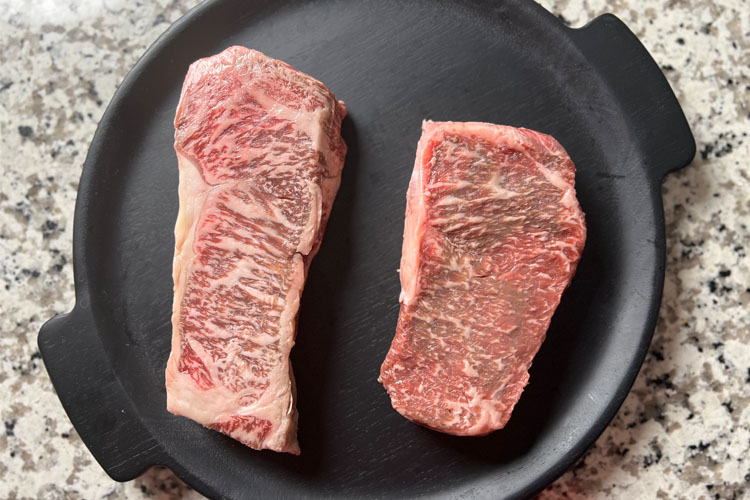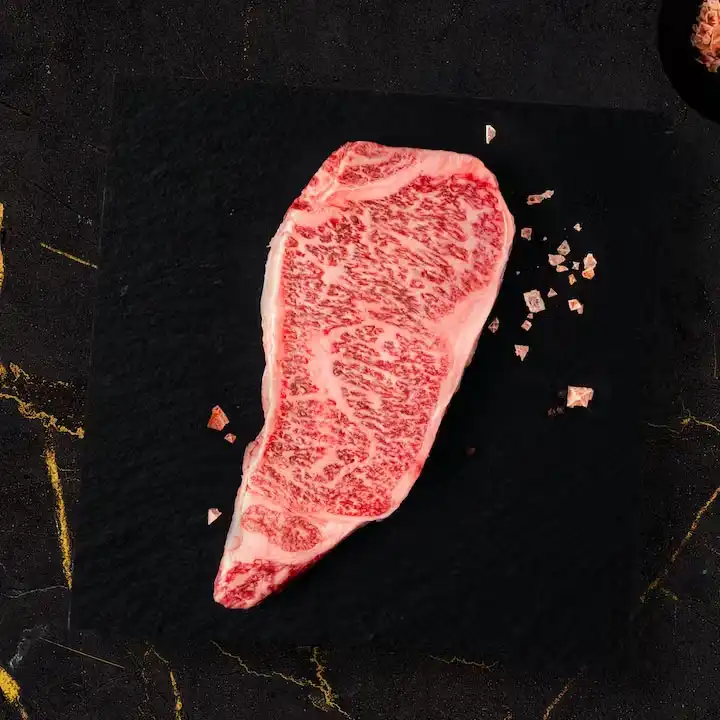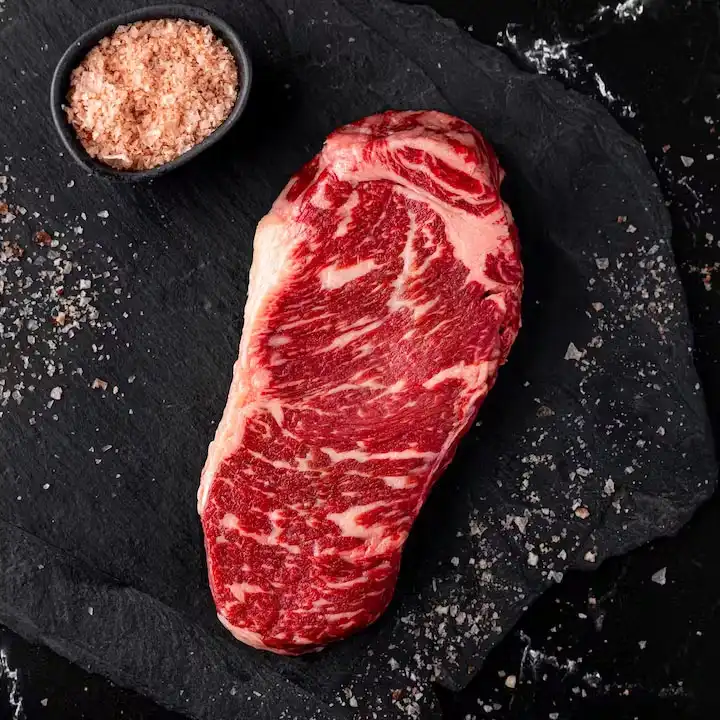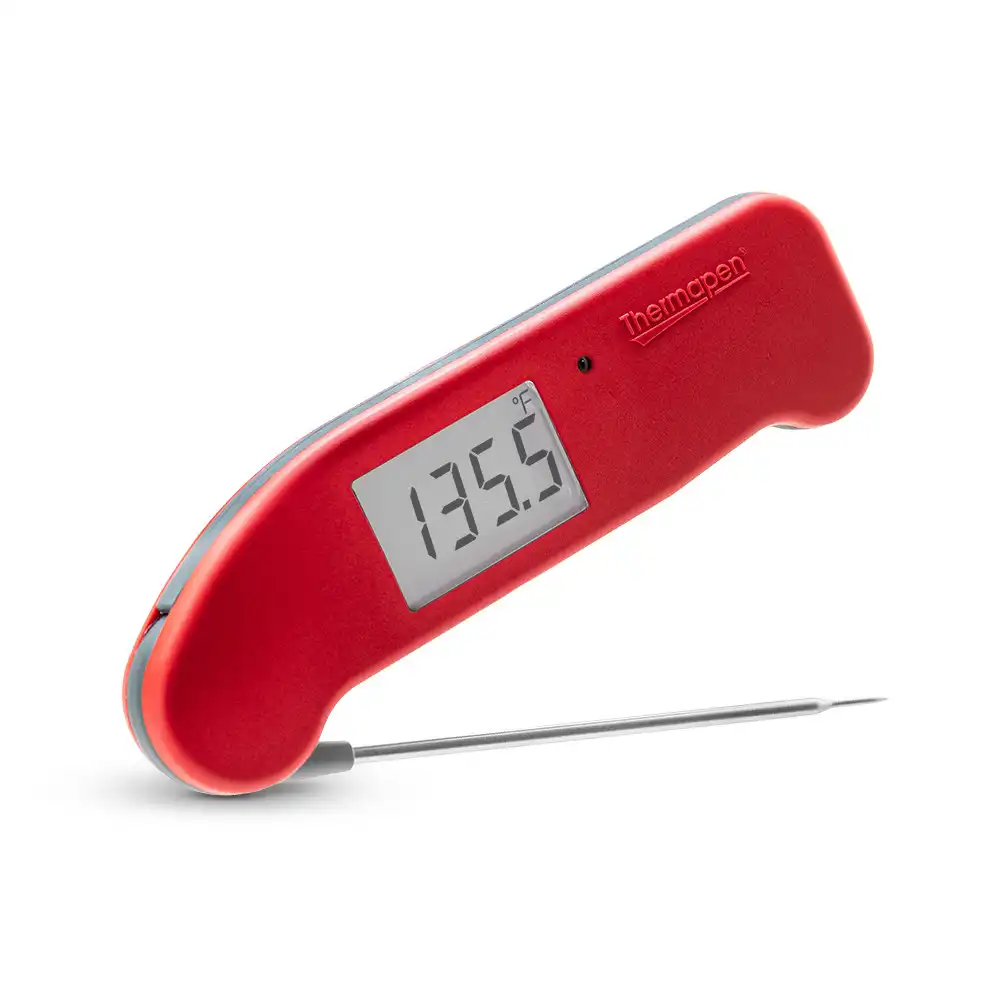Japanese Wagyu vs. American: What’s the Difference, and Which Should You Buy?

With its rich marbling and decadent taste, Wagyu is a prized delicacy across the globe.
But there are a lot of misconceptions and myths surrounding Wagyu beef.
You might see labels in your local grocery store saying “American-style Wagyu” or “Wagyu,” but more than likely, the cuts that you find locally are not true, Japanese-raised Wagyu beef. But, there are some amazing sources of American-raised Wagyu that can be really delicious.
I sourced two beautiful steaks from Crowd Cow to compare the differences between A5 Japanese Wagyu and American Wagyu firsthand.

This article was sponsored by Crowd Cow.
The key differences between Japanese Wagyu and American Wagyu

The first thing I noticed upon opening the steaks is that the Japanese Wagyu was extremely marbled. It was also a thinner cut than the American Wagyu.
The American Wagyu reminded me a lot of a high-quality Prime USDA steak – but even more marbled than I’m used to seeing with Prime steaks.
Japanese Wagu: Kagoshima Wagyu NY Strip

- 100% purebred Japanese Wagyu
- Imported from Japan
- Rated on the Japanese beef rating scale
American Wagyu: Mishima Reserve Ultra Wagyu NY Strip

- Most likely from cross-bred cattle (e.g., Angus & Wagyu)
- Raised and harvested in the United States
- Not USDA rated (though most American Wagyu would qualify for a USDA Prime rating, as that is the highest rating available)
I’ll go through how I went about cooking both the American and Japanse wagyu, but first, it’s worth learning a little bit more about the history behind these two types of steak.
The History of Japanese Wagyu
Wagyu beef originated in Japan. In fact, the word “wagyu” comes from WA (which means Japan) and GYU (which means cow) – therefore, Wagyu simply means “Japanese Cow.”
The prized A4 and A5 wagyu come from a specific breed descended from Tajima-gyu. The breed is known to be extremely high quality and contains a unique and intense amount of intramuscular fat, also known as marbling. These cows have been bred for generations, since the mid-1800s.
Japan has been very careful to restrict the export of their cattle, including cattle DNA, to areas like the United States. But, during a brief time between 1975 and 1997, Japan allowed a small number of these cattle to be exported to the United States.
During this period of export, “American Wagyu” was created.
Imported cattle are crossbred to create American Wagyu
Wagyu has been gaining more and more popularity in the United States, especially with the growing number of ranches offering what is known as American Wagyu.
American Wagyu was first introduced in 1975 when a small number of cattle were imported to the U.S. Since then, there have been generations of crossbreeding to create what is known today as American Wagyu.
American Wagyu is typically crossbred. 100% Wagyu (by DNA) animals are extremely rare in the United States. In fact, there are only about 26,000 of them out of the close to 90 million cattle in the country.
The best way to cook wagyu

Cooking Japanese Wagyu
Cooking a Japanese Wagyu steak is probably the easiest cook you will ever do, albeit the most nerve-wracking because of the high dollar price tag. All you need is a ripping hot pan (or griddle), a bit of salt, and about 1 to 2 minutes per side for the perfect medium-rare to medium wagyu steak.
The high-fat content and succulent flavor of Japanese Wagyu allow the meat to shine on its own without a ton of additional seasoning, sauces, or marinades. The best way to season Japanese Wagyu is simply with a bit of kosher salt or Himalayan sea salt.
When you purchase Japanese Wagyu from Crowd Cow, you can add a jar of their Himalayan Pink Salt to your order that you can use to cook your delicious meat to perfection.

One thing to keep in mind with Japanese Wagyu is that you want to avoid cooking it on your standard grill. Both gas grills and charcoal grills typically have grates (with the exception of gas griddles). As the wagyu cooks, the fat in the steak will render and drip down through the grates. This can rapidly cause a grease fire because of the large fat content of the steak.
To avoid the acrid flavor in your steak due to being cooked over a grease fire, I recommend using a pan or a griddle for cooking Japanese Wagyu.
You want to get a nice sear on each side of the steak at a high temperature, so you don’t overcook the center of the steak.
The ideal temperature for Japanese Wagyu is medium-rare to medium (135-150°F). If you prefer your steaks more well-done, I recommend choosing a different grade of steak.
Cooking American Wagyu
American Wagyu should be cooked just the way you would cook a USDA Prime steak. While it still has a much higher fat content than a typical Prime steak that you would find at your grocery store, it still has a lot of meat between the intramuscular fat.

My favorite way to cook an American Wagyu steak is either on the griddle/flat-top or on a charcoal grill to give it an extra woodfire flavor. While you still may deal with some flare-ups due to the higher marbling in the steak, the risk is not nearly as high as with its Japanese counterpart.
As with any good quality steak, you don’t really need more seasoning than a bit of Kosher salt. You can add a bit of pepper if you like, but other than that, you don’t need much more because the beef has such an amazing flavor that you don’t want to mask it.

Depending on the thickness of your steak, you want to cook it for about 5 to 7 minutes per side to get a perfect medium rare (135°F internal). If you prefer your steaks more well done, American Wagyu can be forgiving in that respect as well. While the steak is really at its best around medium-rare to medium, you could take it all the way to medium-well without losing too much moisture in the meat.
- Crazy fast one second read times
- Large, bright, backlit screen
- Five-year warranty
- It's an expensive piece of kit
What does Japanese Wagyu taste like?
The flavor of Japanese Wagyu is hard to describe, which is probably part of the reason it’s such a coveted delicacy across the globe. You definitely get the flavor of steak, but the high-fat content creates a beautiful richness that really doesn’t compare to any other type of steak.
The steak melts in your mouth and has a much softer texture than other steaks you may have had in the past. Because of the rich flavor and high-fat content, most people won’t enjoy eating more than a few ounces in a sitting. I, personally, can only take a few bites before I’m maxed out.
This makes the Japanese Wagyu steaks from Crowd Cow really perfect for a small group. You can cook a 14 to 16-oz steak and slice it into bites for a few people to share alongside other foods/snacks.
Is Japanese Wagyu worth the price?
I think determining whether something is of value is a very subjective thing, so it’s hard to say whether the high-dollar steak is worth it for each individual person.
In my opinion, Japanese Wagyu is something that everyone should get to try at least once. It really is a special experience, especially when cooked properly. The succulent, flavorful meat is world-renowned for its unique and amazing flavor, and it’s definitely worth trying.
I like to purchase Japanese Wagyu for special occasions because I really enjoy eating it from time to time. It’s not something that I would eat weekly or even monthly, but a few times a year can be really special to enjoy this high-quality cut of steak.
For weekly or monthly steak dinners, American Wagyu is a great alternative at a much more affordable price point.

Where to buy wagyu beef?
One of my favorite places to source both American and Japanese Wagyu is Crowd Cow.
Crowd Cow was founded in 2015 with the aim of providing high-quality and sustainable meats and seafood. To do this, they partner with ethical farms and fisheries from around the world.
When you’re shopping on the Crowd Cow website you can always see exactly where your meat comes from. Whether you’re purchasing Japanese Wagyu, American Wagyu, or a grass-fed steak from them, they offer all the information about the farms and ranches that produce and harvest their beef.
I’ve been shopping at Crowd Cow for over two years now and am extremely happy with the quality of their meat and seafood. I’ve also found the price point makes it possible for everyone to enjoy superb meat and seafood.
So, which should I buy?
I think it honestly comes down to your budget and what type of experience you’re looking for.
If you want a really unique and special experience, then I think you should try Japanese Wagyu – especially if you have never tried it before. It’s rich and succulent, and honestly not like any other steak you will find in the world. The price can be prohibitive, so it’s something that is great for celebrating a special occasion.
If you just want a great, high-quality steak to grill at home, then American Wagyu is a fantastic option. It’s going to have more marbling and better color than a standard USDA Prime steak, and you don’t have to spend a small fortune to enjoy it at home!










